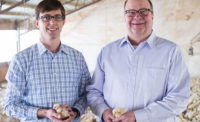Cover Story | Bell & Evans
Bell & Evans: Top-shelf trailblazing
Bell & Evans continues to not only raise the bar, but also redefine what it means to be an innovative company in the chicken-processing industry.












It’s one thing to strive to be an innovator in one or two areas. Maybe a processor is a food-safety superstar; maybe the company strives to retain employees by ensuring they’re supported by best-in-class benefits and safety programs; maybe operations works to be the fastest, most efficient group of plants in the industry. Indeed, it’s one thing to be a pioneer, an explorer and early adopter of new technologies, methods and strategies. But it’s quite another when a processor’s DNA is so hard-wired that it strives — and often succeeds — at trailblazing through almost every initiative it takes on in order to provide the most top-shelf product possible for consumers.
Enter Fredericksburg, Pa., chicken processor Bell & Evans. The 125-year-old company, led today by Scott Sechler Sr. and his two children, Scott Jr. “Buddy” and Margo, has been a top-shelf trailblazer in the industry for decades, likely known best for converting its bird-chilling process from water chill to air chill many years ago in order to offer ultra-premium products.
Yet, air-chilled chicken is only one result of the pioneering spirit that weaves its way through everything Bell & Evans does.
“We started using vacuum-seal packaging in retail about 10 years ago already,” says Scott. “Packaging has been a big part of our changes over the years, and our customers love our diaper-free, recyclable, durable vacuum package.”
Buddy explains that the popularity of the vacuum-seal packaging among consumers has ramped up lately, driven by the fact that the format allows for a cleaner look at the retail shelf, eliminates leakers and the need for sanitizers and secondary bags at the supermarket, and offers a better shelf-life for the products, which also are easier for consumers to freeze and thaw. The conversion of the company’s entire line of fresh chicken product is nearly complete.

Bell & Evans uses innovative incubators and tray systems at its hatchery that give chicks access to water and feed from the moment they hatch, which improves the quality of the chicken products produced later in the supply chain.
“All of our retail packaging is vacuum, and about 95 percent of our bulk product is, but as we grow, it will be 100 percent vacuum-pack,” Buddy says. “In the last three to four years, we’ve gone from two vacuum-pack machines to 12, and almost everything we ship goes out the door vacuum-packed today.”
The reason Bell & Evans can continue to up its own game, the Sechlers say, is the knowledge and support of its own customers for pushing the envelope in big, innovative ways.
“If a customer sees the value in the product and packaging, sees that we’re delivering the value that is charged, they keep coming back,” Scott says. “If they buy a pack of chicken and it leaks on the way home in their new Mercedes’ trunk, that will be the last time they buy that product. … The growth of the category has come at a faster pace, and what is funneling to us is the consumer who says, ‘If I pay $10 for chicken, I expect $10 worth’ — and that’s what we deliver.”
Pioneering production
Animal protein products are only as good as the animals that are raised — and Bell & Evans has driven itself to making life for its chickens better than it is at any other farm in the industry. The company employs a network of family farmers who are held to crucial limits on size of their flocks and high standards for the chicken houses and equipment used to raise Bell & Evans birds.
“The passion is for the chickens, not on the volume,” Scott says. Margo adds that the company doesn’t use farms owned by corporate entities or investor groups. Further, Bell & Evans wants its family farmers to grow responsibly with the company.
“In our case, we only allow a farmer to build two chicken houses and prove him or herself before we’ll let them build a third,” she says. “Then, if they do a really good job of taking care of the birds, we’ll let them build a fourth; but four houses is our limit on any farm.”
Additionally, Bell & Evans requires its chicken houses be constructed to high standards for cleanliness and safety for the chickens. But the company isn’t oblivious to the commitment required to meet those needs.
— Scott Sechler Sr., Bell & Evans
“We help the farmers build the right houses, with cement floors and concrete walls part of the way up the side — to make it more durable and easier to clean out — and equipment that is more durable, more feed-efficient, easier to clean and less rodent-friendly — basically, better for the chickens,” Scott adds. “Our houses probably cost twice as much as the typical industry chicken house, but it’s our farmers’ livelihoods, which they may pass down to the next generations — we want it to be a successful family farm not by volume, but by quality.”
Part of building that success has been inclusion of its farmers in communication about the company and its strategies. Margo has spearheaded a program to keep them understanding their crucial part of the company’s success. Bell & Evans produces a quarterly newsletter to keep team members and growers informed of company happenings and recently hosted small groups of its farm families in Fredericksburg over nine weeks for a plant tour, lunch and informational sessions with company leadership.
“They’re truly the bloodline of the company, so it’s important for us to listen to their input and work together with them, and that sets us apart from others in the industry,” she says. “They’ve been so appreciative to see what we’re doing in Fredericksburg, the transparency and understanding the fact that the family is in it for the long haul — and we’ve had farmers leave excited to build more houses and raise more chickens for us.”
‘Plant’-ing the future
For a processor who has spent decades outpacing many others in terms of innovation, the outside world might wonder what the future could possibly hold. For Bell & Evans, innovation doesn’t simply show up on its doorstep. Scott says the company has been well aware of this, and has always been active in pursuing top-shelf solutions to issues that affect quality and safety.
“In most cases, solutions weren’t brought to us — we went out and found them,” he says. “We’d see a need for something to improve, and we didn’t like the way everyone else has done it, so we’d go out and find solutions somewhere in the world, whether it was Japan, Europe, Canada — wherever it was, we found it and brought it here.”
Bell & Evans’ hatchery in Fredericksburg offers many examples of how the company does things differently than the majority of the industry, having brought solutions from a variety of sources to hatch, sort and raise its chicks specifically to maximize the quality of the chicken products that hit the store shelves. Its processing operations also demonstrate the unique ability to innovative with ultimate product quality in mind.


Moving forward, Bell & Evans will push the envelope even further on the processing side, as it builds and opens a brand-new, green-field processing plant up the road in Fredericksburg. Buddy says the company is on track to break ground in Spring 2020 and begin processing its first birds in late 2021. At presstime, the company was working through the final engineering and planning stages for the facility.
“The first build-out will allow us to almost triple our current production, and we believe that we’ll probably need about one-third of that new plant capacity on Day One of production,” he says. “Around that time, we will likely be running out of space in our current facilities, so we’ll be able to spread out the volumes and back off on some of the extra work we expect to have to do with all the growth we expect.”
The new facility will have the same processes as the current facility, but it will be laid out better to maximize efficiencies that may have suffered as the older plant was expanded and manipulated to meet demand. Bell & Evans is proud of its slow induction anesthesia process and practices, in which birds are not handled by human hands until after they’ve been rendered unconscious, which helps with the quality of the product. Scott says the next iteration of improvement is expected with the new facility.
“We’ve studied and worked with equipment manufacturers on the next greatest equipment to put the chickens to sleep before they are processed,” he explains. “We’ll be the first company in the U.S. to have the truck carrying the birds back in to the system and transfer the modules gently off the trailer onto a conveyor without the bumpy ride of a forklift picking them up and bouncing the birds around. Some processors have put in the stunning system we’re looking at for the new facility, but they didn’t go all the way and complete the loop with the gentle handling on the truck end of it.”
When the new facility opens, the current facility will remain in use, but it will have much less stress put on it, even as demand for Bell & Evans product grows as the company expects. And, even though the new plant signals a new era for this 125-year-old trailblazer, Scott says the company’s DNA won’t change one bit. It will continue to attempt to solve the stickiest issues it sees in the poultry-processing industry and be a pioneer of new ideas and new technologies whenever it benefits the birds, farmers, team members or quality of the final product.
“In the food industry, just about 100 percent of ideas are nickel-and-dimed, and at the end of the day, the consumers are looking for what they want; [they] don’t really want to hear that a company penny-pinched to bring the cost of the product down,” Scott says. “They want to hear that you did everything the right way to bring them the quality and value they’re paying for, and for us, that’s what we take back to design everything we do, to have happy chickens, happy farmers and great quality in our products.” NP
Looking for a reprint of this article?
From high-res PDFs to custom plaques, order your copy today!













